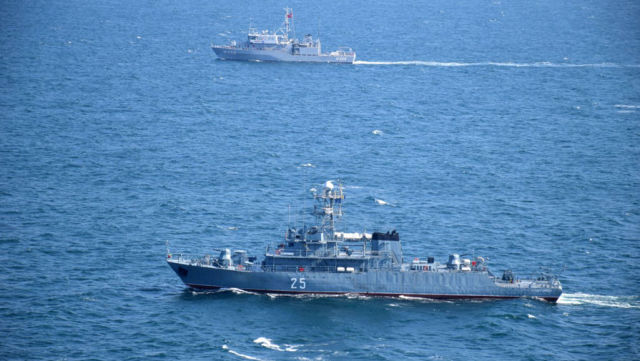NATO military exercise Poseidon 21 launched in the Black Sea
NATO allies-Romania, Bulgaria, France, Greece, Spain, the United States and Turkey-are conducting the Poseidon-21 exercise in the Black Sea, which involves more than 700 military personnel, 13 warships, 9 Rafale and Eurofighter Typhoon aircraft. The maneuvers take place within the framework of the NATO CJET concept, created to ensure the continued presence of allied troops in the Black Sea region.
The multinational naval exercise Poseidon-21, organized by the Romanian Navy (FNR), has started in the Black Sea. Military personnel from Bulgaria, France, Greece, Spain, the United States and Turkey are also taking part in the maneuvers.
The exercise will last until March 6, and will involve more than 700 military personnel, 13 warships, 9 Rafale and Eurofighter Typhoon aircraft, IAR 330 MEDEVAC and Puma Naval helicopters, a Standing NATO Mine Countermeasures Group (SNMCMG2), a cargo ship with pyrotechnics, and a Turkish underwater robot with remote control.
The FNR General Staff report notes that the Poseidon-21 is part of the NATO Joint Advanced Training Program (CJET).
The comprehensive concept of allied training was proposed by Romania at the NATO summit in Warsaw in 2016 to strengthen security measures in the south-eastern part of Europe, as well as to ensure the continued presence of allied troops in the Black Sea region.
"The exercises have a high degree of complexity and are aimed at making optimal use of NATO's capabilities to improve the Alliance's operational response in the context of continuous changes in the regional security environment," the Romanian Defense Ministry said.
The exercise scenario includes joint actions to combat underwater threats, which will involve NATO operational units for hydrographic research, detection and disposal of sea mines and improvised explosive devices.
The divers will coordinate their actions with the aircraft, surface ships. The process of towing the damaged ship, resupply at sea and first aid will also be worked out.
On the eve of the National Defense Control Center of the Russian Federation reported that the Black Sea Fleet of Russia is monitoring the minesweepers-mine seekers Tajo of the Spanish Navy and Europe of the Greek Navy, which entered the Black Sea, Interfax reported.
In the middle of this month, during a two-day video conference of NATO defense ministers, alliance Secretary General Jens Stoltenberg recalled that the alliance concept of 2010 assumed a strategic partnership with Russia, but today "the situation has changed."
"Today, when we carry out deterrence and defense as part of combat groups in the Baltic States and provide a forward presence in the Black Sea region, we conduct air patrols, conduct maritime operations with the participation of our permanent naval formations," the head of the bloc said.
"In particular, three NATO warships are now in the Black Sea. And various NATO countries also conduct their operations in the Black Sea-Turkey, Romania and Bulgaria, the three coastal states work there together with Ukraine and Georgia, our partners. And the allies are investing more. Today, we have unmanned systems operating along our borders, especially in the east and south, " the NATO Secretary General said.
It is worth noting that the troops of the Black Sea Fleet of the Russian Federation (the 11th and 15th coastal missile and artillery brigades) are equipped with missile systems 3K60 " Bal "with an anti-ship missile X-35, K300P "Bastion" with a unified supersonic homing anti-ship cruise missile " Yakhont "("Onyx"). To this is added the coastal mine-based anti-ship "Utes" with the P-35B and 3M44 "Progress" cruise missile systems, as well as the A-222 "Bereg"130-mm coastal self-propelled guns. Thus, in the zone of destruction of missile and artillery systems of the Coastal Troops of the Black Sea Fleet is almost the entire Black Sea.
Andrey Ermolov

